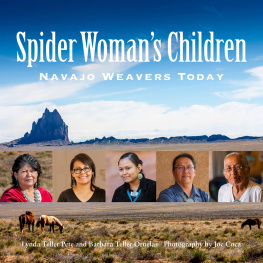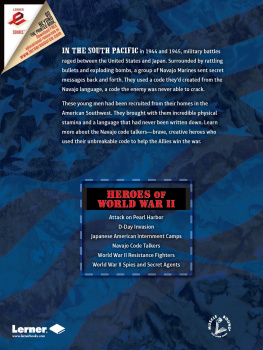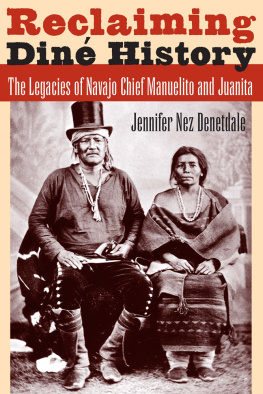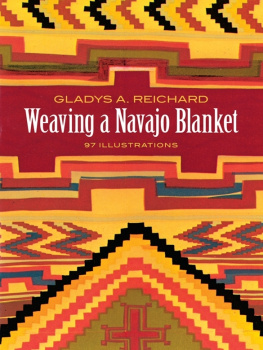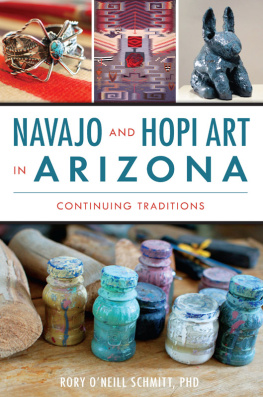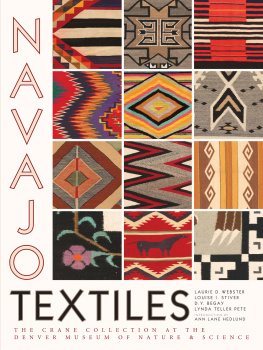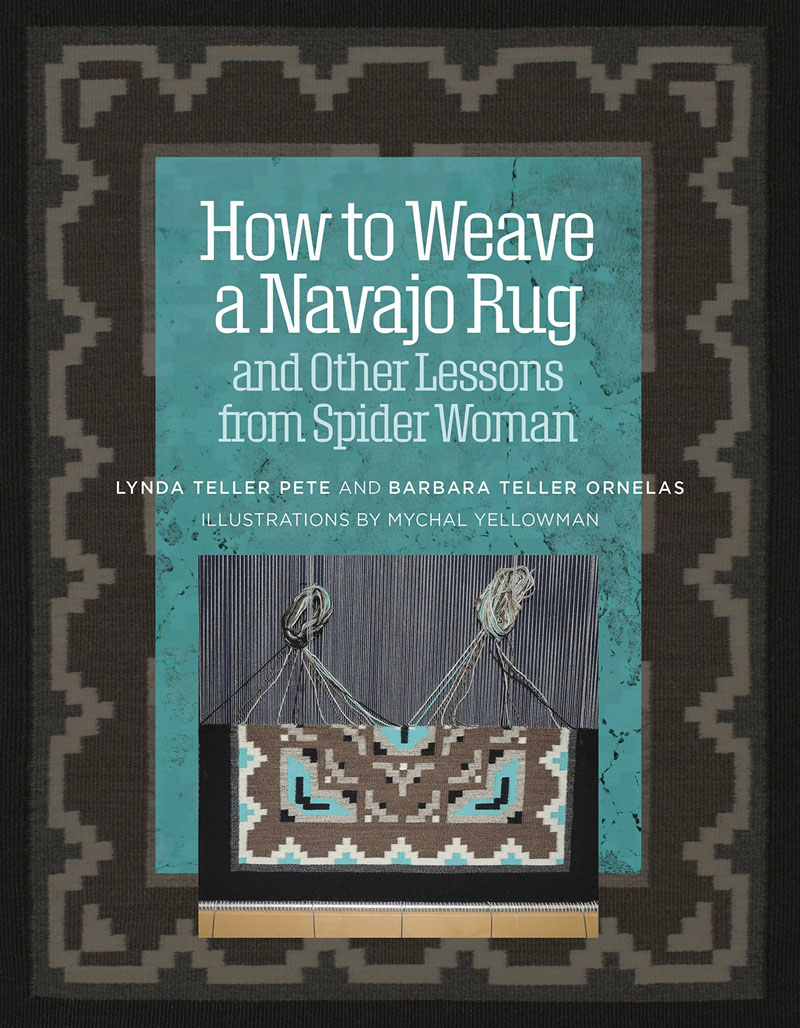Be generous and kind.
Acknowledge and respect kinship and clanship.
Seek traditional knowledge and traditions.
Respect values.
Respect the sacred nature of the self.
Have reverence and care of speech.
Be a careful listener.
Be appreciative and thankful.
Have a balanced perspective and mind.
Show positive feelings toward others.
Expression of appropriate and proper sense of humor.
Maintain strong reverence of the self.
Maintain enthusiasm and motivation for ones work.
Protect and care for ones work.
Technical Editor: Velma Kee Craig | Copyeditor: Kathryn Bright | Design: Launie Parry
Printed in China by Asia Pacific | Library of Congress Control Number: 2020933745
DEDICATION
Barbara and I dedicate this book to the Din weavers who survived The Long Walk. Their perilous and courageous journey to bring weaving back to our homeland within our sacred mountains ensured that our family and countless other Din weavers could continue our weaving traditions and teaching of Navajo weaving to our future generations.

The vast expanse of the Navajo Nation.
ACKNOWLEDGMENTS
Barbara and I would like to acknowledge many family, friends, colleagues, students, book contributors, museums, guilds, and universities. Please be patient; the list is long.
We begin with our parents, Sam and Ruth Teller. Our father built our first looms and tools, and we learned how to weave from our mother. Without our older sister, Rosann Teller Lee, we would be, at best, mediocre weavers and certainly not teachers. Her firm resolve often reduced us to tears, but we live by her motto You are only as good as your last weaving, meaning that with every weaving project, we take no shortcuts, and we cannot rest on our laurels, award ribbons, and prize money; we have to improve with each weaving and weave challenging designs.

Belvin E. Pete
We acknowledge our paternal grandparents, Paul and Nellie Teller, who gave us the traditional teachings of weaving. Every family member is contributing to our weaving lives: our aunts, uncles, brothers, nephews, nieces, numerous cousins, and grandchildren. Every single family member has to contribute for a weaver or a family of Din weavers to be successful. We are grateful that Pauls father, our great grandfather, survived the prison camp at Bosque Redondo and came home to Canyon de Chelly; we recite his weaving songs and prayers today.
Barbaras husband, David, has been instrumental in documentation and led us to our weaving history in print and photos. My husband, Belvin E. Pete, also from a Din weaving family, has brought his engineering and Injun-uity to our weaving and has elevated us into embracing innovation. He has passed on his knowledge of toolmaking to Terry Lee.
Our nephew Terry Lee, our sister Rosanns son, keeps us in weaving tools and surprises us with specialty tools when weaving students have physical challenges. Terry is passing on his toolmaking knowledge to Michael. Barbaras children, sixth-generation weavers Sierra and Michael, have inspired us to weave beyond our Trading Post style of Two Grey Hills tapestry weaving. We still weave Two Grey Hills tapestries, but we are branching into other styles, period styles from the mid to late 1800s and some modern abstracts. Its a little nerve wracking at times but keeps our weaving acumen sharp. We are extremely proud that our seventh generation of grandchildren, Roxanne Rose Lee and Javier Teller Ornelas OMara, will be representing the Teller line of weavers for our future. A large circle of family keeps us humble when we need it, encourages us when we need it, elevates us when we need it, and douses us with humor when we need it. Ultimately, its the genuine love of family and tradition that keeps us weaving.
We have two groups of student weavers, Din students and non-Navajo students, all of whom have been instrumental to this book. Barbara started teaching in 1997, and I joined her in 2000 at Idyllwild School of Arts in Idyllwild, California. We gave our class a one-page handout in 2001, and our handouts have grown in nineteen years, culminating in this book. After every class, at least one student will highlight an error, ask for clarification on a process, or address a weaving issue gone awry. Sometimes in my haste, I make a correction on my smartphone, but since I do not have squirrel fingers, I make more errors. It is the peril of being a teacher.
We acknowledge the Din students who contributed their Din familys weaving traditions and teachings in classes and have enriched our own traditional knowledge.
We acknowledge a special group of students who have become close friends and have been instrumental in building our weaving classes: Leslie Thompson Chatwin, Leanna Mcneilley, Ercil Howard-Wroth, Rocky Gaines, Bill and Carole Greene. And we send a huge thank-you to Pamela Bliss, a floor-loom weaving teacher, colleague, and friend who connected us with weaving guilds.
We acknowledge the museums, curators, and personnel who invited us to collaborate on all things Din weaving: the Heard Museum, Phoenix, Arizona; the Denver Museum of Nature and Science, Denver, Colorado; University of Colorado Museum of Natural History, Boulder, Colorado; the National Museum of the American Indian at the Smithsonian Institution, Washington, DC; the Amerind Foundation and Museum, Dragoon, Arizona; the Colorado Springs Fine Arts Center, Colorado Springs, Colorado; Museum of Texas Tech University, Lubbock, Texas; Mariposa Museum, Peterborough, New Hampshire; Mount Holyoke College Art Museum, South Hadley, Massachusetts; Museum of Indian Arts and Culture, Santa Fe, New Mexico; Arizona State Museum, Tucson, Arizona; American Museum of Natural History, New York, New York; and the Bard Graduate Center, New York, New York.
We acknowledge the many weaving guilds, fiber art centers, universities, art schools, wool mills, and a lot of small private groups that provided an opportunity for us to teach Navajo weaving, cultivating a diverse student population.
We acknowledge the three Din cultural contributors to our book: Freddie Johnson, Cheron Nez Johnson, and Lyle Harvey. Freddie Johnson and his wife, Cheron Nez Johnson, along with their family of six children moved to Tempe, Arizona, for employment and education opportunities; they are dedicated to teaching the Din language and cultural protocols, and they are mentors to those seeking a linkage to their Din heritage. Freddie and Cheron come from a long line of Din weavers. We acknowledge Din educator extraordinaire Lyle Harvey, resident of Rock Point, Arizona, and grandson of Din weavers and four Din medicine men. Using his familys knowledge, he provides cultural stories for Din youth at various schools on the Din Nation.


